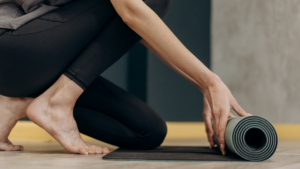In the vast realm of yoga, inversions hold a special place, offering practitioners a unique blend of strength, balance, and mental focus. Among these inversions, Pincha Mayurasana, or the Forearm Stand, stands out as a challenging yet rewarding pose. In this article, we will explore the intricacies of Pincha Mayurasana, its physical and mental benefits, and a step-by-step guide to mastering this empowering yoga posture.
Understanding Pincha Mayurasana:
Pincha Mayurasana, often referred to as the Forearm Stand or Feathered Peacock Pose, is an intermediate to advanced inversion that involves balancing the body on the forearms while the legs extend upward. The name is derived from the Sanskrit words “Pincha,” meaning feather, “Mayura,” meaning peacock, and “Asana,” meaning pose. This asana requires core strength, shoulder stability, and a sense of fearlessness.
Benefits of Pincha Mayurasana:
Strengthens the Core:
The core muscles, including the abdominals and lower back, play a pivotal role in maintaining stability during Pincha Mayurasana. Regular practice strengthens these muscles, promoting a robust and toned core.
Enhances Shoulder Strength:
The pose places a significant demand on the shoulders and arms. Consistent practice helps build strength in the shoulder muscles, including the deltoids and triceps.
Improves Balance and Focus:
Balancing on the forearms challenges the practitioner’s sense of equilibrium and concentration. Pincha Mayurasana encourages mental focus and mindfulness, enhancing overall balance.
Stimulates the Nervous System:
Inversions like Pincha Mayurasana stimulate the nervous system, promoting a sense of invigoration and rejuvenation. The shift in perspective can have uplifting effects on mood and mental clarity.
Strengthens the Upper Back:
The engagement required to lift the legs activates the muscles in the upper back. This contributes to improved posture and a more resilient upper body.
Step-by-Step Guide to Pincha Mayurasana:
Prepare Your Body:
Begin with a thorough warm-up, focusing on the shoulders, core, and hip flexors. Incorporate poses like Downward-Facing Dog, Dolphin Pose, and High Plank to prepare the body for the inversion.
Forearm Placement:
Start in Dolphin Pose with your forearms on the mat, forming a triangle with your hands clasped. Ensure your elbows are shoulder-width apart and directly under your shoulders.
Lift Your Hips:
From Dolphin Pose, walk your feet closer to your elbows, lifting your hips toward the ceiling. Keep your gaze between your forearms, maintaining a neutral neck position.
Engage Your Core:
Activate your core by drawing your navel toward your spine. This engagement provides stability as you transition into the inversion.
Shift Your Weight:
Begin to shift your weight forward, lifting one leg off the mat and then the other. Focus on keeping your core engaged and your hips stacked over your shoulders.
Extend Your Legs:
As you gain confidence, extend both legs upward, reaching toward the ceiling. Flex your feet and engage the leg muscles for a more extended and controlled position.
Maintain Alignment:
Check that your shoulders remain stacked over your forearms, and your body forms a straight line. Avoid overarching or rounding your lower back, aiming for a neutral spine.
Hold the Pose:
Once in Pincha Mayurasana, hold the pose for a few breaths, gradually extending the duration as your strength and comfort level increase.
Exit Mindfully:
To release from the pose, bring one leg down at a time, returning to Dolphin Pose or Child’s Pose. Exit with control to avoid straining the shoulders or lower back.
Pincha Mayurasana stands as a testament to the transformative power of yoga, offering practitioners a journey into strength, balance, and self-discovery. As with any inversion, patience, consistency, and mindfulness are key. Whether you’re a seasoned yogi or just beginning your inversion practice, the journey toward mastering Pincha Mayurasana is an empowering exploration of the body and mind. Embrace the challenges, celebrate the progress, and savor the sense of freedom that comes with defying gravity in this dynamic and uplifting pose.
Also Read: Mastering the art of balance the tolasana pose unveiled






